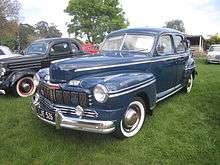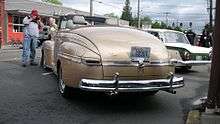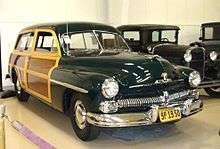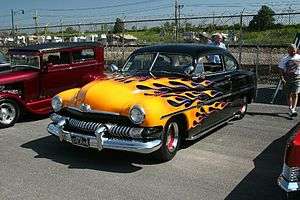Mercury Eight
| Mercury Eight | |
|---|---|
 | |
| Overview | |
| Manufacturer | Mercury (Ford) |
| Production | 1938–1951 |
| Assembly |
Long Beach, California, United States Maywood, California (starting 1948) Dearborn, Michigan, United States Wayne, Michigan, United States St. Louis Missouri, United States Edison, New Jersey, United States |
| Body and chassis | |
| Class | Full-size |
| Layout | FR layout |
| Chronology | |
| Successor | Mercury Monterey |
The Mercury Eight is a full-size automobile that was the first model produced by Mercury and was produced from the 1939 through the 1951 model years. It was the only model offered by Mercury until the marque started producing multiple series in the 1952 model year, at which point it was dropped as a model designation.

1939–1940

| First generation | |
|---|---|
 1939 Mercury 8 Sport Convertible | |
| Overview | |
| Model years | 1939–1940 |
| Body and chassis | |
| Body style |
2-door coupe[1] 2-door convertible[1] 2-door sedan[2] 4-door sedan[1] 4-door convertible[1] |
| Powertrain | |
| Engine | 239 cu in (3.9 L) Flathead V8 |
| Dimensions | |
| Wheelbase | 116.0 in (2,946 mm)[1] |
| Length | 196.0 in (4,978 mm)[1] |

The advertisements for this car declared it to be "The car that truly dares to ask 'Why?'", referring to the idea that a big car couldn't also be economical.[1] The Mercury was priced in the thousand dollar range, several hundred dollars more than the Ford V-8, several hundred less than the Lincoln-Zephyr and about the same as the upper-range Oldsmobile and Dodges, Hudsons, and the lower-range Buicks and DeSotos, sales from all of which, it was hoped, the new Mercury would usurp.[1] Its engine was a 95 hp version of the Ford flathead V8 engine, its styling was inspired by the Zephyr, and it had hydraulic brakes from the beginning.[1] With a wheelbase of 116.0 in (2,946 mm) and an overall length of 196.0 in (4,978 mm), it was a good-sized car, which the Ford company advertised extensively, together with its up-to-20 mpg performance-"few cars of any size can equal such economy."[1] Double sun visors became standard in 1940.[3] Braking was via 12-inch drums.[4]
Although "Eight" script would not appear on the front of the hood until the 1941 model year, sales literature prominently referred to the car as the "Mercury Eight" from the very beginning. This is no doubt because the actual series names, 99A in 1939[1] and 09A in 1940,[1] were somewhat less enticing. A 1940 09A model has the words "Mercury Eight" in an emblem that runs from front to rear alongside the top hood lines on both sides. It appears as chrome wording on top of a double red bar.
By the end of 1940 Mercury could run with the headline "It's made 150,000 owners change cars!"[1]
1941–1948

| Second generation | |
|---|---|
 | |
| Overview | |
| Model years | 1941–1948 |
| Body and chassis | |
| Body style |
2-door coupe[1][5] 2-door convertible[1][5] 4-door sedan[1][5] 4-door station wagon[1][5] 2-door Sportsman convertible |
| Powertrain | |
| Engine | 239 cu in (3.9 L) Flathead V8[5] |
| Dimensions | |
| Wheelbase | 118.0 in (2,997 mm)[1][5] |
| Length |
1941-46: 201.6 in (5,121 mm)[5] 1947-48: 201.8 in (5,126 mm)[5] |
| Curb weight | 3,400–3,800 lb (1,500–1,700 kg) |



The 1941 Mercury Eight got all-new styling and some engineering improvements. The Mercury now shared its bodyshell with Ford, probably to lower Mercury production costs. Mercury's wheelbase was expanded by 2.0 in (51 mm) to 118.0 in (2,997 mm).[1] There were many chassis refinements, including improved spring lengths, rates, and deflections, plus changes in shackling, shocks, and an improved stabilizer bar, but the old fashioned transverse springs were still used. The new body featured door bottoms that flared out over the running boards, allowing for wider seats and interiors. The car had 2.0 in (51 mm) more headroom, two-piece front fenders (three-piece at first), and more glass area. The front pillars were made slimmer and the windshield was widened, deepened, and angled more steeply. Parking lights were separate and set atop the fenders for greater visibility. Headlight bezels were redesigned. In all closed Mercurys the rear-quarter windows opened out. Front vent wings were now crank-operated, and in closed cars the ventilation wing support bars rolled down with the windows. The 4-door convertible, offered in 1940, was gone, but a station wagon was added. The woodie wagon's body behind the engine cowl was identical to Ford's, and produced at the company's Iron Mountain plant in Michigan's Upper Peninsula. The "Eight" script was moved to the rear of the hood. 90,556 Mercury Eights were sold in the 1941 model year.
In 1942 the Mercury Eight's slender bullet parking lights were replaced with rectangular units placed high on the fenders inboard of the headlights. Running boards were now completely concealed under flared door bottoms. The instrument panel now features two identical circles for speedometer and clock with gauges to the left of the speedometer, a glove compartment to the right of the clock, and a large radio speaker cover in the center. The grille looked more like that of the Lincoln-Zephyr and Continental. The "Eight" script was gone but an "8" appeared at the top of the grille center. Horsepower was increased to 100. Mercury's biggest engineering news for 1942 was "Liquamatic," Ford's first semiautomatic transmission. It wasn't much of a success and Mercury wouldn't have another automatic transmission until Merc-O-Matic appeared in 1951, which was of course a true automatic. Mercury production for the short 1942 model year totaled only 1,902. Output was halted in February 1942 as American auto plants were converted to the exclusive production of war material.
Although Mercury's prewar history was short, the Mercury Eight had already earned for itself the image of being a fine performer in mph as well as mpg, this "hot car" image quite in keeping with its name, chosen by Edsel Ford, that of the fleet-footed messenger of the gods of Roman mythology.[1] The Mercury Eight was strongly identified as an upmarket Ford during this period. In 1945 the Lincoln-Mercury division would be established to change that.[1]
A new grille was the most noticeable difference between the 1942 and 1946 Mercurys.[5] It had thin vertical bars surrounded by a trim piece painted the same color as the car.[5] An "Eight" script now appeared down its center. The Liquimatic automatic transmission option was eliminated.[5] The most distinctive new Mercury was the Sportsman convertible.[5] It featured wood body panels.[5] Only 205 examples of it were produced and it was discontinued the following model year.[5] Mercury Eight sales totaled 86,603.[5]
Styling changes were slight in 1947.[5] The Mercury name was placed on the side of the hood.[5] Different hubcaps were used.[5] The border around the grille was chrome plated.[5] The "Eight" script still ran down its center. There was also new trunk trim.[5] More chrome was used on the interior and the dash dial faces were redesigned.[5] The convertible and station wagon came with leather upholstery.[5] The other body styles used fabric.[5] The wood paneled Sportsman convertible was gone.[5] 86,363 Mercury Eights were sold.[5]
For all practical purposes the 1948 Mercury Eights were identical to the 1947s.[5] The major changes consisted of different dial faces and no steering column lock.[5] 50,268 Mercury Eights were sold.[5]
1949–1951

| Third generation | |
|---|---|
 | |
| Overview | |
| Model years | 1949–1951 |
| Body and chassis | |
| Body style |
2-door coupe[5] 2-door Monterey coupe[5] 2-door convertible[5] 4-door sedan[5] 2-door station wagon[5] |
| Related | Lincoln EL-series |
| Powertrain | |
| Engine | 255 cu in (4.2 L) Flathead V8[5] |
| Dimensions | |
| Wheelbase | 118.0 in (2,997 mm)[5][6][7] |
| Length | 206.8 in (5,253 mm)[5][7] |
| Curb weight | 3,500–4,000 lb (1,600–1,800 kg) |


The first postwar Mercury was introduced in the 1949 model year. The engine was a flathead V8 that produced slightly more power than the then also newly designed 1949 Ford. A new overdrive system was optional, activated by a handle under the dash.[7][8] The styling of the Mercury Eight, when it was released in 1949, adopted the "ponton" appearance, and was successful in both ending the monotony of warmed-over pre-war style, and differentiating Mercury from its comparable Ford cousin, a trick that spelled sales success. Sales figures for both Ford and Mercury broke records in 1949. The new approach to styling was also evident on the completely redesigned Lincoln and the all-new Lincoln Cosmopolitan. The Mercury Eight used full instrumentation.[9] An 8 tube radio as an option. The 4-door station wagon was replaced with a 2-door model.[5] Although the wagon now featured an all-metal roof, its sides still consisted of wood panels, manufactured at the Ford Iron Mountain Plant.[5]
Within its era and beyond, the Mercury Eight was popular with customizers. In 1949, Sam Barris built the first lead sled from a 1949 Mercury Eight; the Eight became the definitive lead sled, much as the Ford V-8 (as the "deuce") was becoming the definitive hot rod. The Eights were among the first models to receive an aftermarket OHV engine swap, since Oldsmobile and Cadillac developed the first high-compression OHV V8 engines in 1949, whereas Ford was still using a sidevalve engine. Sam and George Barris also used the 1949 body style to build "the most famous custom car ever",[10] the Hirohata Merc, for customer Bob Hirohata in 1953. Setting a style and an attitude, it had a "momentous effect" on custom car builders,[11] appeared in several magazines at the time,[12] and reappeared numerous times since, earning an honorable mention on Rod & Custom's "Twenty Best of All Time" list in 1991.[12] The Eight remains a very popular subject for car modellers.
Fiberglass replicas of the Eight, inspired by Sam Barris's car, are still in production and are popular with custom and rod enthusiasts.[13]
In 1950, a high-end two-door Monterey coupe was introduced in the same vein as the Ford Crestliner, the Lincoln Lido coupe and the Lincoln Cosmopolitan Capri coupe in order to compete with the hardtop coupes General Motors had introduced the previous model year. The front suspension was independent with stabilizer bars.[14] In 1952 the Monterey would become its own series.
In 1990, Mattel Hot Wheels created a model of 1949 Mercury with a chopped top. It is called Purple Passion. Purple Passion is one of the most desirable and priciest Hot Wheels to ever be cast.
Appearances in popular culture
The car makes notable appearances in a number of films: Rebel Without a Cause (1955), American Graffiti (1973), Badlands (1973), Grease (1978), Christmas Story 2 (2012), and Cobra (1986). Cobra would use one of the first all-fiberglass copies.
A customized 1949 Mercury was also used to play the Batmobile in the Batman and Robin serial.
The character Sheriff from Cars was a 1949 Mercury Police Cruiser.
The car also appears in the video games Hitman: Absolution as the main character's, Agent 47, vehicle and Mafia 2 as the taxicabs.
See also

- Hot rod
- Rat rod
- Leadsled
- Custom Car
- Lowrider
- Kustom Kulture
- George and Sam Barris
- Batman and Robin (serial)
- Rebel Without a Cause
- Badlands (film)
- Cobra (film)
References
- 1 2 3 4 5 6 7 8 9 10 11 12 13 14 15 16 17 18 19 20 21 Kimes, Beverly (1996). standard catalog of American Cars 1805-1942. Krause publications. ISBN 0-87341-428-4.
- ↑ 1940 Mercury Brochure, www.oldcarbrochures.com Retrieved 3 January 2012
- ↑ "Directory Index: Mercury/1940_Mercury/1940_Mercury_Brochure". Oldcarbrochures.com. Retrieved 2013-09-03.
- ↑ "Directory Index: Mercury/1940_Mercury/1940_Mercury_Brochure". Oldcarbrochures.com. Retrieved 2013-09-03.
- 1 2 3 4 5 6 7 8 9 10 11 12 13 14 15 16 17 18 19 20 21 22 23 24 25 26 27 28 29 30 31 32 33 34 35 36 37 38 Kowalke, Ron (1997). Standard Catalog of American Cars 1946-1975. Krause publications. ISBN 0-87341-521-3.
- ↑ "Directory Index: Mercury/1950 Mercury/1950_Mercury_Foldout". Oldcarbrochures.com. Retrieved 2011-11-09.
- 1 2 3 Flory, Jr., J. "Kelly" (2008). American Cars, 1946-1959 Every Model Every Year. McFarland & Company, Inc., Publishers. ISBN 978-0-7864-3229-5.
- ↑ "Directory Index: Mercury/1950 Mercury/album_001". Oldcarbrochures.com. Retrieved 2011-11-09.
- ↑ "Directory Index: Mercury/1950 Mercury/album_001". Oldcarbrochures.com. Retrieved 2011-11-09.
- ↑ Rod & Custom, 8/89, p.12.
- ↑ DeWitt, John. Cool cars, high art: the rise of kustom kulture (University Press of Mississippi, 2001), p.69.
- 1 2 DeWitt, p.70
- ↑ "49 Merc replica (Jan 30, 2009)". 1949-mercury.com. 2008-02-25. Retrieved 2011-11-09.
- ↑ "Directory Index: Mercury/1950 Mercury/1950_Mercury_Foldout". Oldcarbrochures.com. Retrieved 2013-09-03.
External links
- The George Barris website, which featured the first chopped 1949 Mercury (among others).
- Custom cars
| Mercury passenger vehicle timeline, 1940–1979 — next » | ||||||||||||||||||||||||||||||||||||||||||||||||||
|---|---|---|---|---|---|---|---|---|---|---|---|---|---|---|---|---|---|---|---|---|---|---|---|---|---|---|---|---|---|---|---|---|---|---|---|---|---|---|---|---|---|---|---|---|---|---|---|---|---|---|
| Type | 1940s | 1950s | 1960s | 1970s | ||||||||||||||||||||||||||||||||||||||||||||||
| 0 | 1 | 2 | 3 | 4 | 5 | 6 | 7 | 8 | 9 | 0 | 1 | 2 | 3 | 4 | 5 | 6 | 7 | 8 | 9 | 0 | 1 | 2 | 3 | 4 | 5 | 6 | 7 | 8 | 9 | 0 | 1 | 2 | 3 | 4 | 5 | 6 | 7 | 8 | 9 | |||||||||||
| Subcompact | WWII | Bobcat | ||||||||||||||||||||||||||||||||||||||||||||||||
| Compact | Comet | Comet | Comet | Zephyr | ||||||||||||||||||||||||||||||||||||||||||||||
| Monarch | ||||||||||||||||||||||||||||||||||||||||||||||||||
| Mid-size | Montego | Montego | Cougar | |||||||||||||||||||||||||||||||||||||||||||||||
| Meteor | Comet | Comet | ||||||||||||||||||||||||||||||||||||||||||||||||
| Full-size | Custom | Medalist | Meteor | |||||||||||||||||||||||||||||||||||||||||||||||
| Eight | Eight | Eight | Eight | Monterey | Monterey | Monterey | Monterey | Monterey | Monterey | Monterey | ||||||||||||||||||||||||||||||||||||||||
| Montclair | Montclair | Montclair | Montclair | Montclair | Marquis | Marquis | ||||||||||||||||||||||||||||||||||||||||||||
| Park Lane | Park Lane | Park Lane | Park Lane | |||||||||||||||||||||||||||||||||||||||||||||||
| Turnpike Cruiser | S-55 | S-55 | Marauder | |||||||||||||||||||||||||||||||||||||||||||||||
| Station Wagon | Commuter | Commuter | Commuter | Commuter | Commuter | |||||||||||||||||||||||||||||||||||||||||||||
| Voyager | ||||||||||||||||||||||||||||||||||||||||||||||||||
| Colony Park | Colony Park | Colony Park | Colony Park | Colony Park | Colony Park | |||||||||||||||||||||||||||||||||||||||||||||
| Sports car | Capri | Capri II | Capri | |||||||||||||||||||||||||||||||||||||||||||||||
| Cougar | Cougar | |||||||||||||||||||||||||||||||||||||||||||||||||
| Personal luxury | Cougar | Cougar | ||||||||||||||||||||||||||||||||||||||||||||||||
| Pickup Truck | M-Series | M-Series | M-Series | M-Series | ||||||||||||||||||||||||||||||||||||||||||||||